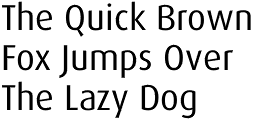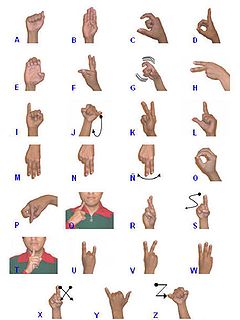
The Cyrillic script is a writing system used for various alphabets across Eurasia, particularly in Eastern Europe, the Caucasus, Central Asia, and North Asia. It is based on the Early Cyrillic alphabet developed during the 9th century AD at the Preslav Literary School in the First Bulgarian Empire. It is the basis of alphabets used in various languages, especially those of Orthodox Slavic origin, and non-Slavic languages influenced by Russian. As of 2011, around 250 million people in Eurasia use it as the official alphabet for their national languages, with Russia accounting for about half of them. With the accession of Bulgaria to the European Union on 1 January 2007, Cyrillic became the third official script of the European Union, following Latin and Greek.

Fingerspelling is the representation of the letters of a writing system, and sometimes numeral systems, using only the hands. These manual alphabets, have often been used in deaf education, and have subsequently been adopted as a distinct part of a number of sign languages; there are about forty manual alphabets around the world. Historically, manual alphabets have had a number of additional applications—including use as ciphers, as mnemonics, and in silent religious settings.

The NATO phonetic alphabet, officially denoted as the International Radiotelephony Spelling Alphabet, and also commonly known as the ICAO phonetic alphabet, and in a variation also known officially as the ITU phonetic alphabet and figure code, is the most widely used radiotelephone spelling alphabet. Although often called "phonetic alphabets", spelling alphabets are unrelated to phonetic transcription systems such as the International Phonetic Alphabet. Instead, the International Civil Aviation Organization (ICAO) alphabet assigned codewords acrophonically to the letters of the English alphabet, so that critical combinations of letters and numbers are most likely to be pronounced and understood by those who exchange voice messages by radio or telephone, regardless of language differences or the quality of the communication channel.

The modern English alphabet is a Latin alphabet consisting of 26 letters, each having an upper- and lower-case form. The same letters constitute the ISO basic Latin alphabet. The alphabet's current form originated in about the 7th century from the Latin script. Since then, various letters have been added, or removed, to give the current Modern English alphabet of 26 letters:
The American Manual Alphabet (AMA) is a manual alphabet that augments the vocabulary of American Sign Language.
Several manual alphabets in use around the world employ two hands to represent some or all of the letters of an alphabet, usually as a part of a deaf sign language. Two-handed alphabets are less widespread than one-handed manual alphabets. They may be used to represent the Latin alphabet or the Cyrillic alphabet.
The Russian Manual Alphabet (RMA) is used for fingerspelling in Russian sign language.
The Korean manual alphabet is used by the Deaf in South Korea who speak Korean Sign Language. It is a one-handed alphabet that mimics the shapes of the letters in hangul, and is used when signing Korean as well as being integrated into KSL.

Latin or Roman script, is a set of graphic signs (script) based on the letters of the classical Latin alphabet. This is derived from a form of the Cumaean Greek version of the Greek alphabet used by the Etruscans.

The Chilean manual alphabet is used by the Chilean deaf community to sign Spanish words and is incorporated into Chilean Sign Language. It is a one-handed alphabet, similar enough to the American manual alphabet for the two to be mutually intelligible, except for the letters Q, T, S and X, U, and the additional letter Ñ.

The French manual alphabet is an alphabet used for French Sign Language (LSF), both to distinguish LSF words and to sign French words in LSF.

The Espanca script is the first signary known of the Paleohispanic scripts. It is inscribed on a piece of slate, 48×28×2 cm. This alphabet consists of 27 letters written double. The 27 letters in the outer line are written in a better hand than those of the inner line, from which it has been inferred that the slate was a teaching exercise in which a master wrote the alphabet and a student copied it.

The Irish manual alphabet is the manual alphabet used in Irish Sign Language. Compared with other manual alphabets based on the Latin alphabet, it has unusual forms for the letters G, K, L, P, and Q.
The ISO basic Latin alphabet is a Latin-script alphabet and consists of two sets of 26 letters, codified in various national and international standards and used widely in international communication. They are the same letters that comprise the English alphabet.
The Yugoslav manual alphabet is two-handed manual alphabet that is used to spell in Yugoslav Sign Language. Some signs are modeled after letters of Serbian Cyrillic alphabet, others after Gaj's Latin alphabet, or stem from other sources.

French Braille is the original braille alphabet, and the basis of all others. The alphabetic order of French has become the basis of the international braille convention, used by most braille alphabets around the world. However, only the 25 basic letters of the French alphabet plus w have become internationalized; the additional letters are largely restricted to French Braille and the alphabets of some neighboring European countries.
Portuguese Braille is the braille alphabet of the Portuguese language, both in Portugal and in Brazil. It is very close to French Braille, with slight modification of the accented letters and some differences in punctuation.

Spanish Braille is the braille alphabet of Spanish and Galician. It is very close to French Braille, with the addition of a letter for ñ, slight modification of the accented letters, and some differences in punctuation. Further conventions have been unified by the Latin American Blind Union, but differences with Spain remain.

The Ukrainian Manual Alphabet is used for fingerspelling in Ukrainian sign language.






































